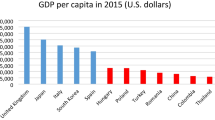Abstract
Under the theoretical framework of the New Trade Theory and the New Economic Geography, Home Market Effects (HMEs) is considered to be important sources of comparative advantage and significant reasons for industry agglomeration. Through the analysis on the input-output tables in China, the paper confirms the existence of HMEs for the manufacturing industries and their export trades on the national and provincial level in China. Several conclusions have been drawn in this study. Firstly, there exist prominent HMEs for manufacturing industries related with nondurable goods and materials in China. Secondly, 10 of the 15 kinds of manufacturing industries considered in this study display the existence of HMEs. Thirdly, the comparative advantage of factor endowment for the export trade of manufacturing industries is declining, while HMEs for them are increasing. Fourthly, among the 30 provincial regions studied in this paper, 11 regions show the existence of HMEs, most of which are located in the eastern coast region. This paper illustrates the simultaneous existence of the comparative advantage of factor endowment and scale economies of HMEs for China’s manufacturing industries. HMEs will not only be the new dynamic for the increase of manufacturing industries and their export trade, but also be the primary power for urban economic growth, industry improvement, and urban space expansion for China.
Similar content being viewed by others
References
Crozet M, Trionfetti F, 2008. Trade costs and the Home Market Effect. Journal of International Economics, 76(2), 309–321. doi: 10.1016/j.jinteco.2008.07.006
Davis D R, Weinstein D E, 1996. Does economic geography matter for international specialization. Research Working Paper, 5706. Cambridge: National Bureau of Economic.
Davis D R, Weinstein D E, 1999. Economic geography and re gional production structure: An empirical investigation. European Economic Review, 43(2): 379–403. doi: 10.2139/ssrn.56190
Davis D R, Weinstein D E, 2003. Market access, economic geography and comparative advantage: An empirical test. Journal of International Economics, 59(12): 1–23. doi: 10.1016/S0022-1996(02)00088-0
Domeque N, Fillat C, Sanz F, 2009. The home market effect in Spanish industry, 1965–1995. The Annals of Regional Science, Online First, October, 1–18. doi: 10.1007/s00168-009-0338-z.
Fjita M, Krugman P, Venables A J, 2000. The Spatial Economy: Cities, Regions, and International Trade. Cambridge: Cambridge University Press.
Head K, Ries J, 2001. Increasing returns versus national product differentiation as an explanation for the pattern of U.S. Canada trade. American Economic Review, 91(4): 858–876. doi: 10.1257/aer.91.4.858
Helpman E, Krugman P, 1985. Market Structure and Foreign Trade. Cambridge: Cambridge University Press.
Jiang Manqi, Zhang Zhiqiang, 2008. Study on the factors for spatial concentration of manufacture industry: Empirical analysis by panel data approach. Nankai Economic Studies, 26(1): 143–52. (in Chinese)
Krugman P, 1980. Scale economies, product differentiation, and the pattern of trade. America Economic Review, 70(5): 950–959. doi: 10.1.1.163.7117
Lin Faqin, Tang Yihong, 2010. Comparative advantage, home market effect and China manufactured products export. Journal of International Trade, 36(1): 18–24. (in Chinese)
Liu Linqing, Li Wenxiu, 2009. Comparative advantage, FDI, and indigenous industrial international competitiveness: Study on the vulnerability of international competitiveness of the Chinamade. China Industrial Economics, 27(8): 47–57. (in Chinese)
Liu Yang, Jin Fengjun, 2009. The historical path and mechanism for industrial structure evolvement in northeast China. Economic Geography, 29(3): 431–436. (in Chinese)
National Bureau of Statistics of China, 1998–2008. Input-output Tables in China. Beijing: China Statistics Press. (in Chinese)
Ou Xiangjun, Zhao Qing, 2007. Quantitative analysis of factors of regional economic inequality in Jiangsu Province with regional separation index. Geographical Research, 26(4): 693–704. (in Chinese)
Qian Xuefeng, Chen Liufu, 2007. Measuring the home market effects between Sino-US bilateral trade: On Chinese trade policy orientation. World Economy Study, 26(12): 49–53. (in Chinese)
Qian Xuefeng, Liang Qi, 2007. The home market effect: Recent developments in theoretical and empirical research. China Economic Quarterly, 6(3): 969–990. (in Chinese)
Schumacher D, 2003. Home market and traditional effects on comparative advantage in a gravity approach. DIW Discussion, 344.
Siliverstovs B, Schumacher D, 2007. Using the gravity equation to differentiate among alternative theories of trade: Another look. Applied Economics Letters, 14(14): 1065–1073. doi: 10.1080/13504850600706446
Wang Lei, Chen Xiangdong, 2009. Study on dynamic convergence of regional innovation between China and Japan. Science Research Management, 30(2): 9–16. (in Chinese)
Weder R, 1995. Linking absolute and comparative advantage to the intra-industry trade theory. Review of International Economics, 3(3): 342–354. doi: 10.1111/j.1467-9396.1995.tb00076.x
Wei Hao, 2008. Empirical analysis on the regional export difference in China. Journal of International Trade, 33(8): 10–17. (in Chinese)
Wu Yumin, Li Jianxia, 2006. Analysis of China’s provincial industrial total factor productivity based on geographical weighted regression model. Economic Geography, 26(5): 748–752. (in Chinese)
Zhang Fan, Pan Zuohong, 2006a. Domestic demand and create a foreign trade of China’s economic development. Journal of Chongqing University of Posts and Telecommunications (Social Sciences Edition), 18(3): 330–333. (in Chinese)
Zhang Fan, Pan Zuohong, 2006b. The role of home market effects in China’s domestic production. China Economic Quarterly, 5(2): 307–328. (in Chinese)
Author information
Authors and Affiliations
Corresponding author
Additional information
Foundation item: Under the auspices of Humanities and Social Sciences Research Fund Project of Ministry of Education of China (No. 2009JJD790014, 10YJA790005)
Rights and permissions
About this article
Cite this article
Zhang, X., Ning, Y. Evaluation of role of Home Market Effects in China’s manufacturing industries. Chin. Geogr. Sci. 21, 211–221 (2011). https://doi.org/10.1007/s11769-011-0458-0
Received:
Accepted:
Published:
Issue Date:
DOI: https://doi.org/10.1007/s11769-011-0458-0




